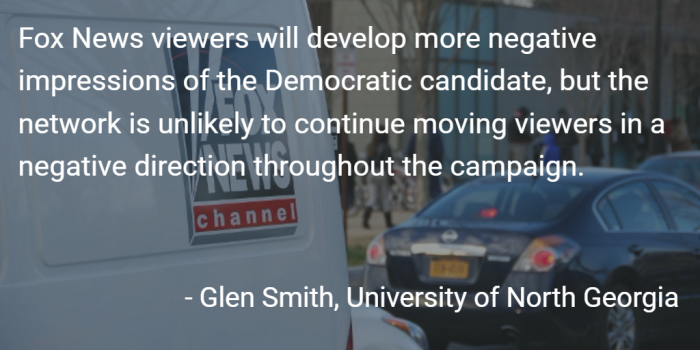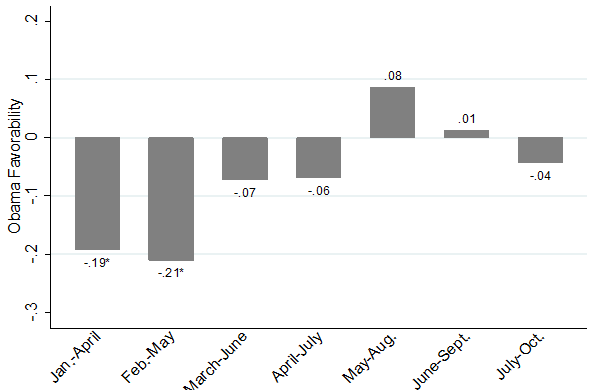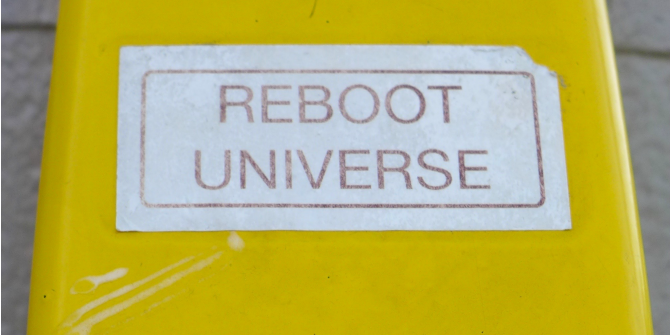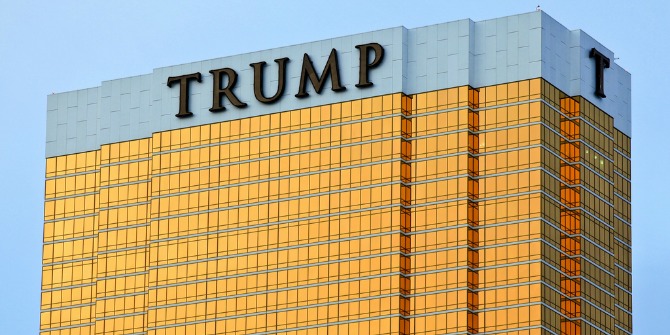 The media has played a massive role in the 2016 election, with many attributing Donald Trump’s popularity to the coverage given to his campaign by television networks such as Fox News and CNN. But what effect does media bias have on the public’s opinion of a candidate? In new research which examines Fox News’ coverage of Barack Obama during the 2008 election, Glen Smith finds that negative coverage can influence the public’s impression of a candidate, but only very early in an election year. He also finds that partisan media likely help to lead to more divisive primary elections by making opposing viewers more negative toward their party’s eventual nominee.
The media has played a massive role in the 2016 election, with many attributing Donald Trump’s popularity to the coverage given to his campaign by television networks such as Fox News and CNN. But what effect does media bias have on the public’s opinion of a candidate? In new research which examines Fox News’ coverage of Barack Obama during the 2008 election, Glen Smith finds that negative coverage can influence the public’s impression of a candidate, but only very early in an election year. He also finds that partisan media likely help to lead to more divisive primary elections by making opposing viewers more negative toward their party’s eventual nominee.
Partisan media outlets have garnered a great deal of attention from politicians and political commentators. During the 2016 Presidential election, cable television came under scrutiny for its treatment of the candidates. While Donald Trump carried out a public feud with Fox News anchor Megyn Kelly, others accused her colleague Sean Hannity of acting as a de facto campaign surrogate for the Republican nominee. Meanwhile, the hosts of Morning Joe on MSNBC came under attack for lobbing softball questions to Trump during the primaries, but were later subject to frequent attacks by the nominee once their coverage turned more critical. Although political candidates commonly accuse the media of bias, it is unclear how much effect those supposed biases have on public opinions of the candidates.
So how do partisan media affect public opinion? Research suggests that partisan media are more likely to reinforce previous opinions rather than change them. Once people have an impression of a candidate, they tend to process new information in a way that supports their established opinion. For example, a Hillary Clinton supporter will counter-argue negative media coverage of the candidate, while uncritically accepting positive media coverage. Consequently, partisan media are unlikely to persuade many of their audience members. Republicans already agree with Fox News, while Democrats are motivated to counter-argue or completely ignore everything the network says.
Despite these limitations, research suggests that partisan media increases negativity toward political candidates and lowers support for bipartisanship. But when do partisan media have their largest effects on viewers? Previous studies have implicitly assumed that partisan media would have the same effects on audiences in April of an election year as they do in October. In recent research, I examined how Fox News affected attitudes toward Obama at different periods of the 2008 presidential election. While I focused exclusively on Fox News for methodological reasons, MSNBC is likely to have a similar effect on viewers. Previous research shows that Fox News made viewers more negative toward Obama in 2008 (see here and here), but no study sufficiently examines the timing of those effects. I argue that partisan media are most likely to affect public impressions of the candidates very early in the election year.
During the party primaries, viewers have weak and uninformed impressions of the candidates, and opposing partisans are less motivated to defend their in-party candidates from attacks. By the time the general election arrives, partisan media have already persuaded their like-minded viewers, while opposing partisans are motivated to ignore opposing media. As a result, partisan media will affect like-minded and opposing partisans during the primary, but those effects largely disappear during the general election. Late in the year, partisan media are limited to less politically sophisticated viewers who pay little attention to political news, but as you might guess, they make up a small portion of the partisan media audience.

To examine the effects of partisan media, I use multiple approaches and two different survey datasets that were conducted over the entire 2008 election year. The survey data come from the internet and telephone portions of the National Annenberg Election Study (NAES), which were conducted at the same time on different respondents. Respondents in the internet panel survey were re-interviewed over the course of the year, while the telephone survey contacted a different sample each day. I also use content analysis data from the Campaign Coverage Index (CCI), gathered by the Project for Excellence in Journalism.
For the first part of the analysis, I examine whether increased exposure to partisan media predicted greater attitude change among viewers. To the extent that partisan media had any affect at all, those effects are likely to be more pronounced among viewers that watch more programs on partisan media networks. Conversely, if increased exposure to partisan media does not predict opinion change, the latter is probably caused by some other factor. Exposure to Fox News is measured as the number of Fox News programs (out of 10) that respondents indicating watching during the spring wave of the survey. Candidate impressions are measured using feeling thermometer ratings of Barack Obama from very unfavorable (0) to very favorable (100).
My results suggest that exposure to Fox News predicted a decrease in favorability toward Obama early in the election year. Exposure to each additional Fox News program predicted a 0.80 reduction in favorability toward Obama early in the campaign; meaning that those watching 10 Fox News programs became 8 points less favorable toward Obama from the spring (January – April) to the summer (May-July) of 2008. During the general election period, increased exposure to Fox News had no apparent relationship with change in Obama favorability from the summer to the fall (August – October) waves of the survey. In other words, those watching a lot of programs on Fox News were no more likely to change their opinions of Obama than those who never watch Fox News.
Next, I used variation in Fox News coverage to predict variation in viewers’ attitudes toward Obama. In brief, I used the coverage of Obama on the week prior to the interview to predict changes in favorability toward Obama the following week. If Fox News devoted more attention to Obama in a given week, Fox News viewers should become less favorable the following week. As expected, increased coverage of Obama preceded lower favorability among viewers during the primaries, but not the general election. From spring to summer, exposure to an additional 30 minutes of Fox News coverage of Obama predicted 3.24 points lower favorability toward Obama, compared to a 0.15 decrease from the summer to fall. Additionally, this pattern was similar among Republicans, Independents and Democrats, suggesting that Fox News was not simply preaching to the choir of Republican viewers.
Using the telephone survey allowed me to breakdown the over-time effects of Fox News on Obama during four month periods throughout the 2008 election year. Figure 1 shows the effects of an additional 30 minutes of weekly Fox News coverage of Obama on his favorability (from 0-10) among respondents saying they preferred Fox News as their primary news source. The results suggest that Fox News had its largest effects during the first few months of the year, but little to no effect during the summer and fall months. From February through the end of May, and additional 30 minutes of Fox News coverage predicted a 0.21 decrease in favorability among Fox News viewers the following week. In contrast, increased coverage of Obama on Fox News had almost no effect on Obama’s favorability from June through October. To be clear, over the last five months of the election, increased coverage of Obama on Fox News did not predict subsequent negativity among Fox News viewers.
Figure 1 – The effects of Fox News on Obama Favorability

Partisan media are able to affect viewers during the primaries because they have weak and uninformed opinions of the candidates. As people learn more about the candidates, the Fox News effect diminishes. If this is true, we would expect to see partisan media effects diminish more among the politically knowledgeable compared to the politically uninformed. That is exactly what I found, as Fox News affected low knowledge viewers both early and late in the election, though the effect was nearly cut in half. Among high knowledge viewers however, Fox News coverage lowered favorability toward Obama early in the election, but those effects disappeared over the last five months. In short, partisan media effects appear to diminish among politically knowledgeable viewers more than low knowledge viewers.
Party primaries also offer partisan media the opportunity to influence opposing partisans during periods of inter-party competition. That is, Fox News may be able to affect Democrats who are unmotivated to defend Democratic candidates that they do not support in the primary. To test this, I examine the effect of Fox News on Democrats who supported Obama in the primary compared to viewers who supported another candidate. It stands to reason that Democrats supporting Obama in the primary would have more motivation than non-supporters to defend him from attacks by Fox News. The results provide consistent evidence that Fox News had a large effect on Democrats who did not support Obama in the primary, but had no effect on Obama’s supporters. During the general election period, exposure to Fox News did not predict changes in Democrat’s favorability toward Obama, regardless of who they supported in the primary. For what it’s worth, a similar analysis of MSNBC found that the network made Republicans less favorable toward McCain, but only when Republicans supported a different candidate in the primaries. These results provide preliminary evidence that partisan media might contribute to divisive primaries by making opposing viewers more negative toward their party’s eventual nominee.
What do these results mean for the role of partisan media in electoral campaigns? Partisan media appear to help viewers form their initial impressions of the candidates, but do little to move viewers after the impressions are formed. As a result, Fox News viewers will develop more negative impressions of the Democratic candidate, but the network is unlikely to continue moving viewers in a negative direction throughout the campaign. Perhaps more interesting is the effect that partisan media have on opposing partisans. Democrats watching Fox News became more negative toward Obama, but only during the primary and only if they supported another Democrat for the nomination. When Fox News attacked Obama, Hillary Clinton supporters were not motivated to reject the attacks, resulting in more negative impressions of the eventual Democratic nominee. Although these results are preliminary, they suggest that partisan media may contribute to divisive primaries.
This article is based on the paper, ‘The Timing of Partisan Media Effects during a Presidential Election’ in Political Research Quarterly.
Featured image credit: Adam Fagen (Flickr, CC-BY-NC-SA-2.0)
Please read our comments policy before commenting.
Note: This article gives the views of the author, and not the position of USApp– American Politics and Policy, nor of the London School of Economics.
Shortened URL for this post: http://bit.ly/2fwlsNf
______________________
 Glen Smith – University of North Georgia
Glen Smith – University of North Georgia
Glen Smith is an Associate Professor at the University of North Georgia. His research focuses on partisan media effects and selective exposure.






